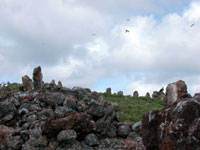NOWRAMP
2002
Mokumanamana
(9/10/02)
Posted
by Scott Kikiloi
Photos by Andy Collins
 There
was a sense of mystery to Mokumanamana, as we arrived to
the island around 7 a.m. in the morning today. The sky was
cloudy and the island stood tall in the middle of the ocean.
From on board the Rapture I could see the religious cultural
sites that ran across the ridge of the island. Getting on
to the island went smoothly as the seas were calm. The zodiac
didn't have any problems getting us all on safely. Once
on the island, we did a oli kahea to ask for ancestral permission
to enter this sacred place. Mokumanamana is perhaps one
of the most interesting cultural phenomenons in Hawaiian
traditions, as there are over fifty-two cultural sites on
the island. What is even more interesting is the fact that
thirty-three of these sites are religious heiau. There has
been some debate in the past by archaeologists on whether
these sites were produced by Hawaiians or other
There
was a sense of mystery to Mokumanamana, as we arrived to
the island around 7 a.m. in the morning today. The sky was
cloudy and the island stood tall in the middle of the ocean.
From on board the Rapture I could see the religious cultural
sites that ran across the ridge of the island. Getting on
to the island went smoothly as the seas were calm. The zodiac
didn't have any problems getting us all on safely. Once
on the island, we did a oli kahea to ask for ancestral permission
to enter this sacred place. Mokumanamana is perhaps one
of the most interesting cultural phenomenons in Hawaiian
traditions, as there are over fifty-two cultural sites on
the island. What is even more interesting is the fact that
thirty-three of these sites are religious heiau. There has
been some debate in the past by archaeologists on whether
these sites were produced by Hawaiians or other  Polynesians
such as Tahitians or Marquesan people. Archaeologists looked
at the style of stone masonry and did comparative studies
between different island groups to come to these conclusions.
It is my thought however that these cultural sites are of
Hawaiian origin. Similar types of structures are found on
Haleakala and Maunakea in our main Hawaiian chain. These
types of sites are usually found in areas that are prominent
and ideal for tracking star movements and navigational studies.
This may give us clues about these heiau on Mokumanamana
and how they may have functioned similarly in the past.
Once we got to the top of the first ridge it seemed very
likely that many of the uprights on these structures were
meant to line up with different points in the sky. There
are still many unanswered questions and there is great need
for these ideas to be studied further.
Polynesians
such as Tahitians or Marquesan people. Archaeologists looked
at the style of stone masonry and did comparative studies
between different island groups to come to these conclusions.
It is my thought however that these cultural sites are of
Hawaiian origin. Similar types of structures are found on
Haleakala and Maunakea in our main Hawaiian chain. These
types of sites are usually found in areas that are prominent
and ideal for tracking star movements and navigational studies.
This may give us clues about these heiau on Mokumanamana
and how they may have functioned similarly in the past.
Once we got to the top of the first ridge it seemed very
likely that many of the uprights on these structures were
meant to line up with different points in the sky. There
are still many unanswered questions and there is great need
for these ideas to be studied further.
 Much
of the day was spent hiking the island and taking photographs
of the endemic flora and fauna. Mokumanamana is the nesting
spot for thousands of sea birds, and as Kahape`a has put
it, "there's so many eggs around, its like being in
an Easter egg hunt." Under the direction of Beth Flint,
from the U.S. Fish and Wildlife Service, we were careful
not to unnecessarily stress the native birds, and tried
to avoid them as much as possible. The native plants that
we saw throughout the day were the `ohai, the `ihi, the
`akulikuli, the aweoweo, and a native type of grass. I thought
it was interesting how natural it seemed for these native
birds to nest on the native shrubbery. There are very few
pristine ecosystems like this left on O`ahu, and I felt
very fortunate to spend my whole day on this island. I love
archaeology and cultural sites, I love native plants and
animals. These are the things we need to continue to protect
for tomorrow.
Much
of the day was spent hiking the island and taking photographs
of the endemic flora and fauna. Mokumanamana is the nesting
spot for thousands of sea birds, and as Kahape`a has put
it, "there's so many eggs around, its like being in
an Easter egg hunt." Under the direction of Beth Flint,
from the U.S. Fish and Wildlife Service, we were careful
not to unnecessarily stress the native birds, and tried
to avoid them as much as possible. The native plants that
we saw throughout the day were the `ohai, the `ihi, the
`akulikuli, the aweoweo, and a native type of grass. I thought
it was interesting how natural it seemed for these native
birds to nest on the native shrubbery. There are very few
pristine ecosystems like this left on O`ahu, and I felt
very fortunate to spend my whole day on this island. I love
archaeology and cultural sites, I love native plants and
animals. These are the things we need to continue to protect
for tomorrow.
<<Journals
Home